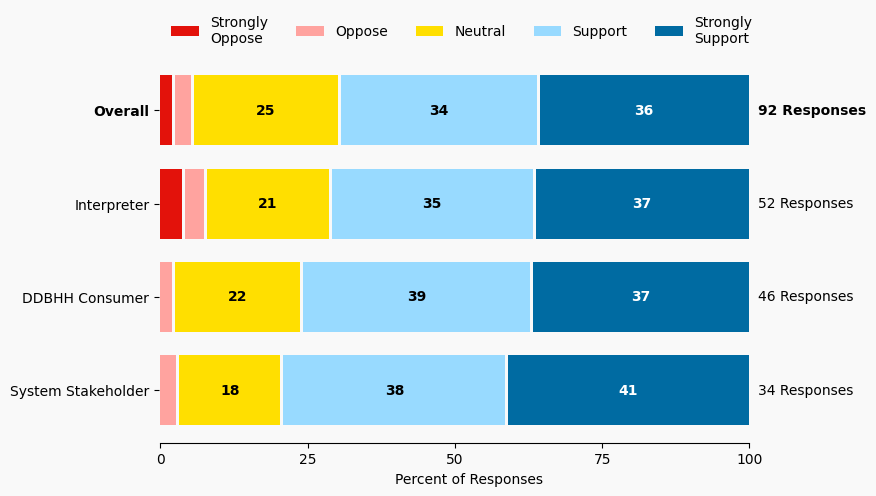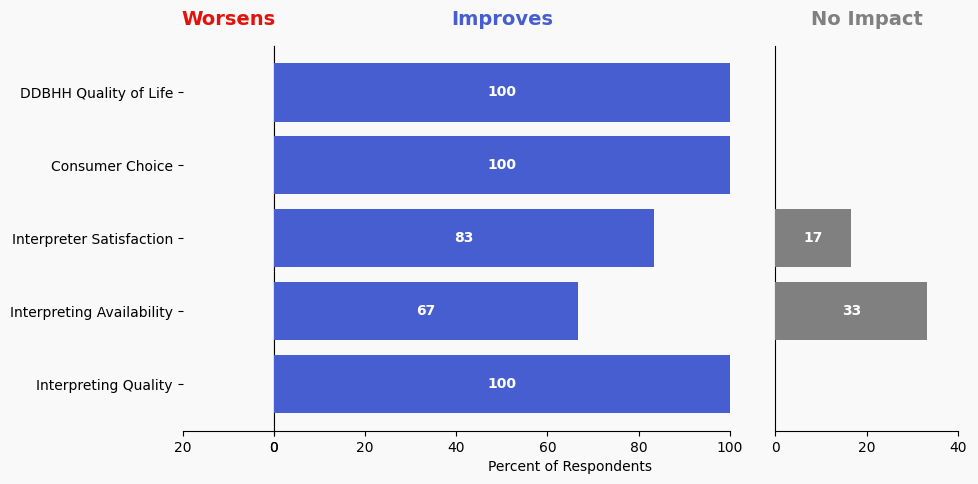85 Minnesota Judicial Branch Court Interpreter Program Consistently Enforce Rule 8 Prioritizing Interpreters Holding RID’s Specialist Certificate: Legal (SC:L)
Issue: Rule 8 is a policy that requires court scheduling staff to attempt to schedule SC:Ls first. Currently, not all scheduling staff follow Rule 8, thus resulting in any interpreter on the roster or through a subcontracted agency being sent for court proceedings.
Proposed Solution: Commission, Disability Law Center and the Olmstead Implementation Office collaborate to work with MJB to return to this best practice of first seeking SC:Ls as the most qualified interpreters for DDBHH Minnesotans in the legal system.
Expected outcome: MJB will provide better services for and avoid any violation of rights for DDBHH Minnesotans. DDBHH Minnesotans will experience justice more on par with their peers who do not have a hearing loss.
Who is impacted: Consumers, court interpreters
Timeline: 6 months

Summary of Support Image Description
The stacked bar charts show how respondents rated their level of support and the total number of responses. The percentage for the five support levels is shown from left to right: Strongly Oppose (Dark Red), Oppose (Light Red), Neutral (Yellow), Support (Light Blue), and Strongly Support (Dark Blue).
Respondents may identify with multiple subgroups. The overall level of support is:
Overall
Strongly Oppose: 2%
Oppose: 3%
Neutral: 25%
Support: 34%
Strongly Support: 36%
Click to see the detailed image description for each subgroup.
Interpreter
Strongly Oppose: 4%
Oppose: 4%
Neutral: 21%
Support: 35%
Strongly Support: 37%
DDBHH Consumer
Strongly Oppose: 0%
Oppose: 2%
Neutral: 22%
Support: 39%
Strongly Support: 37%
System Stakeholder
Strongly Oppose: 0%
Oppose: 3%
Neutral: 18%
Support: 38%
Strongly Support: 41%
Overview of Respondents Opting for In-Depth Solution Analysis
After indicating their support level, 4% of the 92 respondents opted in to further assess whether the solution would worsen or improve on five metrics. Of the opt-in reviewers (4 respondents), 25% supported the solution, 50% were neutral on the solution, and 25% opposed the solution.
The remaining 88 respondents did not opt in to further assess the solution. Of these people, 71% support the solution, 23% were neutral on the solution, and 4% opposed the solution.
Reviewer Evaluation of Solution Effectiveness

Solution Effectiveness Image Description
The stacked bar charts show how respondents assessed the effectiveness of this solution based on five metrics. For each metric, the percentage of respondents is shown from left to right: Worsens (Red), Improves (Blue), No Impact (Gray).
DDBHH Quality of Life
Makes It Worse 0%
Makes It Better 100%
No Impact 0%
Interpreter Satisfaction
Makes It Worse 0%
Makes It Better 83%
No Impact 16%
Consumer Choice
Makes It Worse 0%
Makes It Better 100%
No Impact 0%
Interpreting Availability
Makes It Worse 0%
Makes It Better 66%
No Impact 33%
Interpreting Quality
Makes It Worse 0%
Makes It Better 100%
No Impact 0%
Reviewer Feedback and Insights
Interpreter
One comment from Interpreters expresses skepticism, noting that bringing back the test could perpetuate divisions among interpreters. Another comment calls for “in-services” for judges, lawyers, and court staff. One comment supports keeping SC:L as the first choice, but raises concerns about the current system favoring out-of-state interpreters over local ones, which may drive interpreters to leave the field.
Deaf, DeafBlind, Hard of Hearing
One comment from DDBHH Consumers expresses a preference for prioritizing SC:L but questions whether the Minnesota Judicial Branch (MJB) would view this within their scope, expressing doubt that OIO has a role in this issue.
System Stakeholder
One comment from a System stakeholder suggests working with advocacy organizations like DVSA to guide the approach based on their experience.
PREVIOUS SOLUTION
84 Provide Legal Interpreting Workshop Series
Issue: Insufficient number of qualified interpreters for legal interpreting.
NEXT SOLUTION
Issue: Insufficient number of qualified interpreters for legal interpreting. The RID SC:L is no longer offered.
Leave a Reply